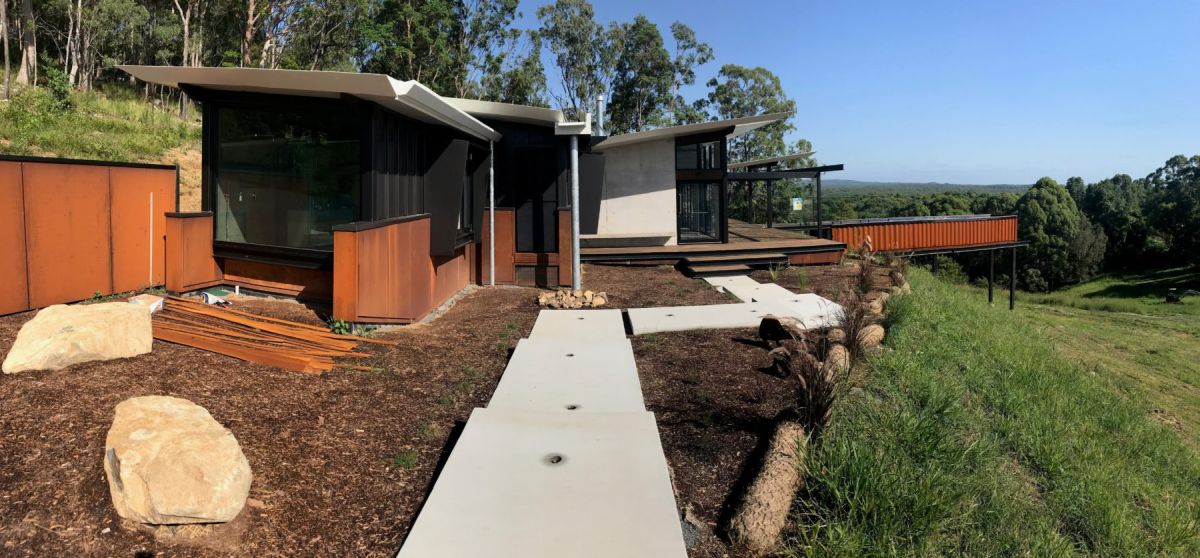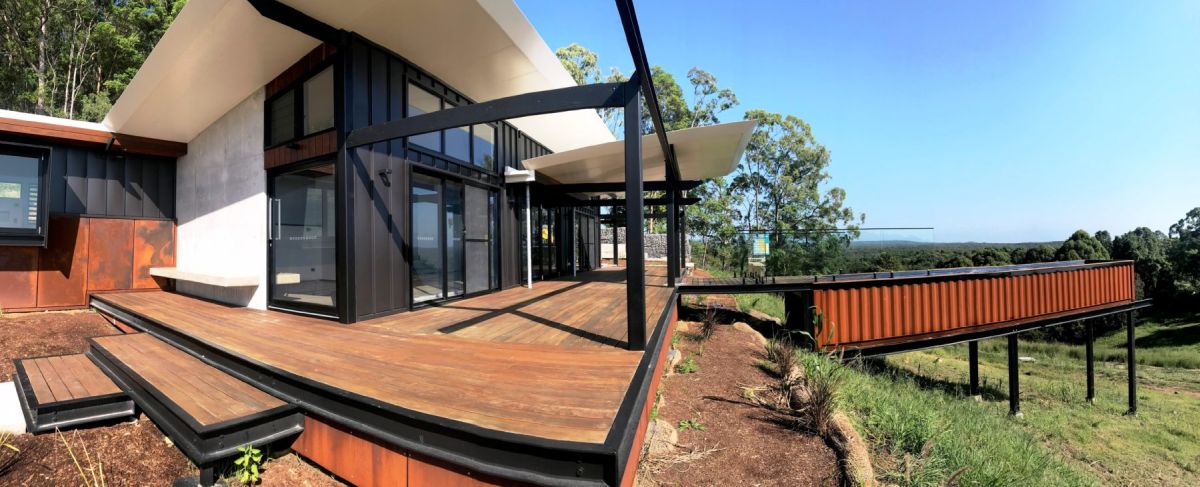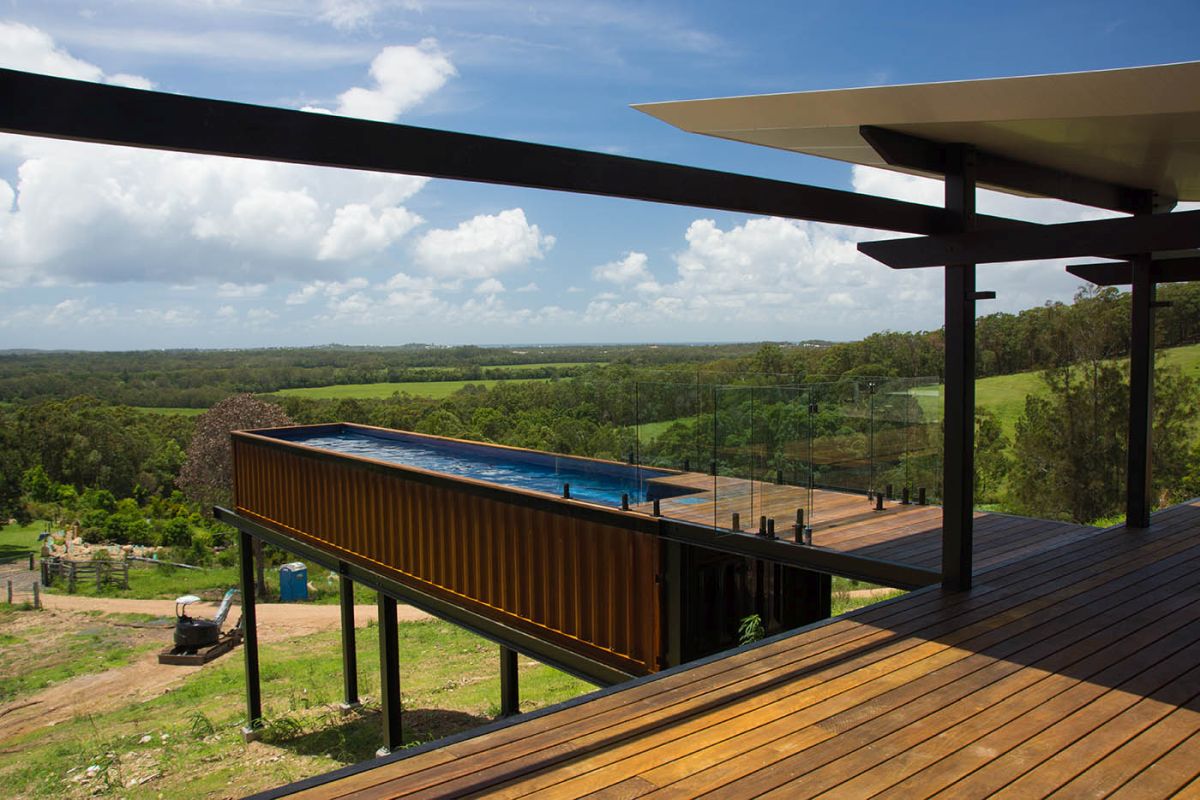An Amazing Split-Level Home With A Shipping Container Pool
Shipping containershave become quite popular lately seeing how they can be repurposed into all sorts of cool housing projects. But that’s not all. A company calledShipping Container Poolsproduces…you guessed it…swimming poolsmade out of repurposed shipping containers.
 View in gallery
View in gallery
It’s not the first time we’ve stumbled upon this concept but it is inspiring and interesting to see the details nevertheless. This is a house byGibson Building, located in Noosa Hinterlands in Australia. It’s a split-level retreat with a modest size and design and with a big personality.
How Much Does It Cost to Put in a Shipping Container Pool?
Shipping container poolscan differ in price according to your requirements, but on average, they will end up costing you anything from $28,000 to $50,000. The cost is determined on the size of the pool and any optional amenities selected.
Are Shipping Container Pools Good?
As always, the correct answer depends on what it is that you’re hoping to obtain from ashipping container pool. They can be customized to meet individual requirements. You can add wood paneling to give them a spa-like feel and prevent them from looking like cargo containers. The pool’s length makes it ideal for training and lap swimming.
Shipping container poolsare more elegant and cost-effective than traditional pools. You may not need to construct a fence around an above-ground pool, which saves you money. It is sufficient to have a gate that restricts admission.
They are also highly portable, at least when compared to other types of pools. Your pool can accompany you from one house to the next, ensuring that your investment pays off. They are just as simple to install as fiberglass pools and are ready to use immediately upon completion.
 View in gallery
View in gallery
 View in gallery
View in gallery
 View in gallery
View in gallery
 View in gallery
View in gallery
This is a two-bedroom contemporary home designed for a client who insisted onhaving a 40 ft container pool. The pool is suspended on a steel frame over the sloping ground and is placed perpendicular to the deck and the house. This layout is as practical as it is eye-catching and mesmerizing, thecantilevered poolmaking the most out of the views and emphasizing the open and wild nature of the whole property. We love the rusty, industrial look of the facades and the pool’s exterior and we think it helps to give this house a lot of character.
 View in gallery
View in gallery
 View in gallery
View in gallery
 View in gallery
View in gallery
 View in gallery
View in gallery
 View in gallery
View in gallery
 View in gallery
View in gallery
 View in gallery
View in gallery
 View in gallery
View in gallery
 View in gallery
View in gallery
How to Build Your Own Shipping Container Pool
 View in gallery
View in gallery
如果你准备把一些重活,这里is what you have to know about what it takes tobuild your own shipping container pool.
Step One
To begin, obtain planning approval from your local council and research any restrictions governing depth, fencing, and other factors that could obstruct the construction. It is far preferable to resolve these issues prior to beginning construction than to be saddled with a 40-foot modified shipping container that is not brimming with people having fun in the water.
Step Two
You’ll probably want to have someone with an expertise in structural engineering on hand to assist with planning as well. You’ll want to reinforce the container to support the additional weight pressing out from the interior, as containers are built to support their weight on their base and corners. They will be able to provide you with the guidance you require to ensure the strength and durability of your new pool.
Step Three
你需要决定你未来的高度container pool. Calculate the required depth and make the necessary cuts. You’ll want to include a lip around the edge to conceal any sharp edges and to reinforce the container’s structure.
Step Four
Following that, you’ll need to seal the container. While containers are watertight on the exterior, they are not designed to keep water on the inside. Shipping containers are often lined with plywood, which is not ideal for water retention, so you’ll need to add an additional layer to keep your pool full. This is often accomplished through watertight welding and the installation of an additional layer of steel to the inside of the container.
Step Five
You also have to consider rust treatment and painting the interior and exterior of the container.
Step Six
Add the plumbing components, such as pumps, intake pipes, and filters, and you’re nearly finished. Consult your local pool provider about the best method for your location, taking into account available electricity, water supply, and drainage.
Step Seven
Install the pool and enjoy!
FAQ
Are Shipping Containers Toxic?
This is the most frequently asked concern by prospective container home buyers, and it is mostly motivated by the risk of harmful chemicals in the flooring, which could potentially have chromate or phosphorus.
While purchasing a new shipping container straight from a manufacturer would be a simple answer, this would also eliminate your eco-conscious dreams.
Certain straightforward answers are the most practical. Spray foam insulation on all interior wall panels significantly increases your container’s efficiency and also acts as a vapor barrier against any possibly dangerous contaminants in the wall paint.
If you want to be absolutely safe from any chemicals in your flooring, you can make a trip to your local hardware store and purchase marine plywood to replace the existing floor.
Can Shipping Container Pools Be in Ground?
It is planned as an above-ground pool, but if the site is inclined, it can be partially in-ground. However, a retaining wall or an outside wall would need to be constructed around the pool to avoid contact with the soil.
How Much Does It Cost to Turn a Shipping Container Into a Pool?
One of the most alluring characteristics of shipping container pools is their low cost. The average cost of a container pool varies from $20,000 to $30,000, making them affordable to a large number of homeowners.
Some pools can cost as little as $6,000 but be aware that the build quality may not meet the standards required for a big investment like a swimming pool that must survive for many years.
Tips for Sealing a Shipping Container Pool
Typically, shipping containers are lined with plywood flooring that are unsuitable for containing water. When converting a container into a dwelling, it is common to waterproof it from the outside. However, because the container will be filled with water, waterproofing will take place inside.
Consider watertight welding
This is a waterproofing method that requires installing steel sheets. This method of waterproofing entails the use of steel sheets. Before the shipping container is rust-treated and painted, there is a steel layer welded inside.
This steel is used to cover both the walls and the inner base. Three protective coatings are then put to this surface: epoxy resin for marine use, marine grade enamel, and anti-corrosive metal primer.
This form of waterproofing is great for do-it-yourself projects, as welding may be done in your backyard. It is the most effective method of waterproofing used containers.
If rust reappears, you can repair it with a coat of paint. Due to the ease with which steel can be cut, you may easily install a viewing glass for your pool.
Get waterproof concrete for deeper pools
This particular sealing procedure involves attaching a steel wire mesh to the container’s wall. This mesh and foam work together to create a foundation for the concrete to be placed on the container’s inside walls.
Once the concrete has cured adequately, the inside walls can be covered with tiles. It will inhibit the formation of algae in your pool and also provide a high-quality finish.
It is a less expensive method of waterproofing than steel and fiberglass approaches. This approach is suitable for pools with a depth greater than 8 feet. In comparison to vinyl pool liners, this is a low-maintenance approach that is great for beach entrance.
选择玻璃纤维插入为低成本维护
This approach uses fiberglass to waterproof your container pool. This free-standing fiberglass structure is strong enough to withstand the pool’s water load.
It enhances the aesthetic attractiveness of your pool and has a higher resale value than a vinyl pool liner. One of the major benefits is the fact that long-term maintenance is not going to cost you that much.